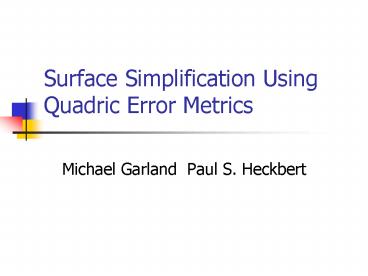Surface Simplification Using Quadric Error Metrics - PowerPoint PPT Presentation
1 / 31
Title:
Surface Simplification Using Quadric Error Metrics
Description:
Place all the pairs in a heap keyed on cost with the minimum cost pair at the top ... v2) of the least cost from the heap, contract this pair and update the costs of ... – PowerPoint PPT presentation
Number of Views:82
Avg rating:3.0/5.0
Title: Surface Simplification Using Quadric Error Metrics
1
Surface Simplification Using Quadric Error Metrics
- Michael Garland Paul S. Heckbert
2
Why Simplification?
- Full complexity of models is not always required
- Reduce the computational cost
- Get fast processing speed
3
Objective
- Find a surface simplification algorithm that can
be used in rendering systems for multiresolution
model - Efficient
- Good quality
- Generality
- Join unconnected regions of the model together
---- aggregation
4
Categories of surface simplification algorithms
- Vertex Decimation
- Vertex Clustering
- Iterative Edge Contraction
5
Vertex Decimation
- Basic idea
- Iteratively selects a vertex for removal, removes
all adjacent faces, and retriangulates the
resulting hole. - Pros provide reasonable efficiency and quality
- Cons only limited to manifold surfaces
6
Vertex Clustering
- Basic idea
- A bounding box is placed around the original
model and divided into grids - Vertices within each cell are clustered together
into a single vertex and model faces are updated
accordingly - Pros
- Fast
- Can make drastic topological alterations
- Cons
- Output quality is very low
7
Iterative Edge Contraction
- Cons do not support aggregation
8
Assumptions
- Model only consists of triangles
- The topology of the model need not to be
maintained - In a good approximation, points do not move far
from their original positions
9
Algorithm overview
- Iteratively contract vertex pairs ( a
generalization of edge contraction) - As the algorithm proceeds, a geometric error
approximation is maintained at each vertex of the
model which is represented using quadric matrices - The algorithm proceeds until the simplification
goals are satisfied.
10
Pair Contraction
11
Advantages of pair contraction
- Achieve aggregation, which can join previously
unconnected regions of the model together - Algorithm is less sensitive to the mesh
connectivity of the original model
12
Edge contraction vs. pair contraction
Regular grid of 100 closely spaced cubes
Approximation using edge contraction
Approximation using pair contraction
13
Pair Selection
- Select the set of valid pairs at initialization
time - A pair (V1, V2) is a valid pair for contraction
if either - (V1, V2) is an edge, or
- V1 V2 lt t, where t is a threshold parameter
14
Pair contraction
- Initially, each vertex is associated with the set
of pairs of which it is a member - After performing contraction (V1, V2) ? V1
- V1 acquires all the edges that were linked to V2
- Merge the set of pairs from V2 into its own set
and remove duplicate pairs
15
Error approximation
- Associate a symmetric 4?4 matrix Q with each
vertex - The error at vertex v is defined as the quadratic
form ?(v) vTQv. - For a given contraction (v1, v2) ? v, a new
matrix Q needs to be derived to approximate the
error at v. - Q Q1 Q2
16
Find the position for v
- Simply select either v1, v2, or (v1v2)/2 which
produces the lowest value of error at v (?(v)
vTQv). - Find a position for v which minimizes ?(v)
17
Compute the initial Q matrices
- Associate a set of planes with each vertex
- Define the error of the vertex as the sum of
squared distances to the planes
Here pa b c dT represents the plane defined by
equation axbyczd0, and a2b2c21
18
Quadratic form
Kp is defined as fundamental error quadric.
19
Algorithm summary
- Compute the Q matrices for all the initial
vertices - Select all valid pairs and compute the optimal
contraction target v for each valid pair (v1,
v2). - The cost of contracting the pair is computed as
vT(Q1Q2)V - Place all the pairs in a heap keyed on cost with
the minimum cost pair at the top - Iteratively remove the pair (v1, v2) of the least
cost from the heap, contract this pair and update
the costs of all valid pairs involving v1, v2.
20
Approximation evaluation
- The approximation error Ei of the simplified
model Mi is defined as
Mn ---- the initial model. Xn ---- sets of
points sampled on model Mn Xi ---- sets of
points sampled on model Mi
21
Result(1) ---- an example sequence of
approximations
5,804 faces
994 faces
532 faces
248 faces
64 faces
An example sequence of approximations generated
by the algorithm. The entire sequence was
constructed in about one second.
22
Result(2) sample running times
Time needed to make a 10 face approximation of
the given model.
23
Result(3) effect of optimal vertex placement
Choosing an optimal position can significantly
reduce approximation error.
24
Result(4) ---- bunny model
69,451 triangles
1,000 triangles
100 triangles
1.4 of original size
0.14 of original size
25
Result(5) ---- Terrain model
199,114 faces
999 faces (46 secs)
26
Result(6) ---- comparison between different
methods
Original model
Edge Contractions
(250 faces)
(4,204 faces)
Uniform Vertex Clustering
Pair Contractions
(250 faces)
(262 faces)
27
Result(7) ---- level surfaces of error quadrics
1000 face approximation
250 face approximation
28
Result(8) ---- initially valid pairs
29
Result(9) -- effect of pair thresholds
30
Conclusion
- This paper presents a surface simplification
algorithm using iterative pair contractions and
quadric error metrics. - The algorithm can provide high efficiency, high
quality and high generality.
31
Future works
- Use a more sophisticated adaptive scheme to
select valid pairs - Take the color of surface into account































